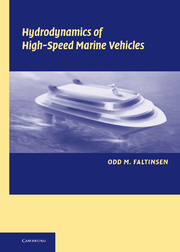Book contents
- Frontmatter
- Contents
- Preface
- List of symbols
- 1 INTRODUCTION
- 2 RESISTANCE AND PROPULSION
- 3 WAVES
- 4 WAVE RESISTANCE AND WASH
- 5 SURFACE EFFECT SHIPS
- 6 HYDROFOIL VESSELS AND FOIL THEORY
- 7 SEMI-DISPLACEMENT VESSELS
- 8 SLAMMING, WHIPPING, AND SPRINGING
- 9 PLANING VESSELS
- 10 MANEUVERING
- APPENDIX: Units of Measurement and Physical Constants
- References
- Index
6 - HYDROFOIL VESSELS AND FOIL THEORY
Published online by Cambridge University Press: 15 September 2009
- Frontmatter
- Contents
- Preface
- List of symbols
- 1 INTRODUCTION
- 2 RESISTANCE AND PROPULSION
- 3 WAVES
- 4 WAVE RESISTANCE AND WASH
- 5 SURFACE EFFECT SHIPS
- 6 HYDROFOIL VESSELS AND FOIL THEORY
- 7 SEMI-DISPLACEMENT VESSELS
- 8 SLAMMING, WHIPPING, AND SPRINGING
- 9 PLANING VESSELS
- 10 MANEUVERING
- APPENDIX: Units of Measurement and Physical Constants
- References
- Index
Summary
Introduction
Hydrofoil vessels in foilborne conditions generally have good seakeeping characteristics, create small wash, and have small speed loss due to incident waves. This is particularly true for fully submerged foil systems. Foils are normally designed for subcavitating conditions. However, the possibility of cavitation is then an important issue. Our discussion assumes subcavitating foils.
Johnston (1985) pointed out that important aspects when selecting foil and strut configurations of fully submerged hydrofoils are:
Maintenance of directional and roll stability
Stable recovery when a foil comes out of the water (broaches)
Graceful deterioration of performance in severe seas
Safety
The designer tries to maximize the foil's lift-to-drag ratio and the speed for cavitation inception. Further, the weight of the strut-foil system must be minimized with due consideration of structural strength.
Abramson (1974) discussed relevant structural loads for monohull hydrofoil vessels. In this context, important aspects are slamming, hull-bending moments in foilborne conditions, and bending of the forward foil and strut during recovery from a forward foil broach. Slamming on the side hulls of a foil catamaran is not considered a problem. The reason is large deadrise angles. Because a monohull hydrofoil vessel typically uses a planing hull with relatively small deadrise angles, slamming loads matter. If a foil catamaran is hullborne in bad weather, wetdeck slamming must be considered. The possibility of grounding and hitting of objects like logs against the strut-foil system must also be considered.
Flutter of foils and struts could cause catastrophic failure, but this has never occurred.
- Type
- Chapter
- Information
- Hydrodynamics of High-Speed Marine Vehicles , pp. 165 - 220Publisher: Cambridge University PressPrint publication year: 2006
- 1
- Cited by



